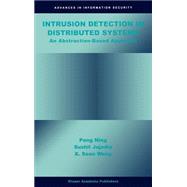
| Dedication | v | ||||
| List of Figures | xi | ||||
| List of Tables | xiii | ||||
| Preface | xv | ||||
| Acknowledgments | xvii | ||||
| 1. INTRODUCTION | 1 | (6) | |||
|
1 | (1) | |||
|
2 | (2) | |||
|
4 | (1) | |||
|
5 | (2) | |||
| 2. AN OVERVIEW OF RELATED RESEARCH | 7 | (6) | |||
| 3. SYSTEM VIEW AND EVENT HISTORY | 13 | (6) | |||
|
14 | (5) | |||
|
17 | (2) | |||
| 4. MODELING REQUEST AMONG COOPERATING INTRUSION DETECTION SYSTEMS | 19 | (18) | |||
|
20 | (6) | |||
|
24 | (2) | |||
|
26 | (6) | |||
|
26 | (2) | |||
|
28 | (4) | |||
|
32 | (5) | |||
|
32 | (1) | |||
|
33 | (1) | |||
|
34 | (3) | |||
| 5. EXTENDING COMMON INTRUSION DETECTION FRAMEWORK (CIDF) TO SUPPORT QUERIES | 37 | (18) | |||
|
38 | (3) | |||
|
39 | (2) | |||
|
41 | (13) | |||
|
41 | (6) | |||
|
47 | (3) | |||
|
50 | (4) | |||
|
54 | (1) | |||
| 6. A HIERARCHICAL MODEL FOR DISTRIBUTED ATTACKS | 55 | (16) | |||
|
56 | (6) | |||
|
62 | (6) | |||
|
68 | (3) | |||
|
68 | (1) | |||
|
68 | (1) | |||
|
69 | (2) | |||
| 7. DECENTRALIZED DETECTION OF DISTRIBUTED ATTACKS | 71 | (20) | |||
|
71 | (2) | |||
|
73 | (6) | |||
|
79 | (5) | |||
|
84 | (2) | |||
|
86 | (5) | |||
|
86 | (5) | |||
| 8. CARDS: AN EXPERIMENTAL SYSTEM FOR DETECTING DISTRIBUTED ATTACKS | 91 | (20) | |||
|
91 | (3) | |||
|
91 | (2) | |||
|
93 | (1) | |||
|
94 | (1) | |||
|
94 | (7) | |||
|
95 | (1) | |||
|
96 | (3) | |||
|
99 | (2) | |||
|
101 | (12) | |||
|
101 | (1) | |||
|
102 | (1) | |||
|
103 | (4) | |||
|
107 | (4) | |||
| 9. CONCLUSION | 111 | (2) | |||
| Appendices | 113 | (14) | |||
|
113 | (4) | |||
|
113 | (1) | |||
|
113 | (2) | |||
|
115 | (2) | |||
|
117 | (10) | |||
|
117 | (1) | |||
|
117 | (1) | |||
|
118 | (1) | |||
|
118 | (2) | |||
|
120 | (2) | |||
|
122 | (5) | |||
|
122 | (1) | |||
|
123 | (1) | |||
|
124 | (3) | |||
| References | 127 | (8) | |||
| Index | 135 |
The New copy of this book will include any supplemental materials advertised. Please check the title of the book to determine if it should include any access cards, study guides, lab manuals, CDs, etc.
The Used, Rental and eBook copies of this book are not guaranteed to include any supplemental materials. Typically, only the book itself is included. This is true even if the title states it includes any access cards, study guides, lab manuals, CDs, etc.